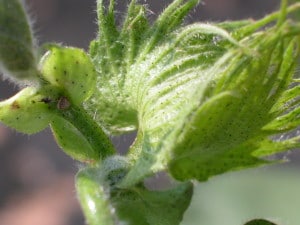The few reports I’ve received this week indicate that tarnished plant bug pressure is lower. It’s not uncommon for average numbers to backslide, after an initial flurry in early squaring cotton, as populations become spread out over more acres. There have been some reports of nymphs showing up early, so consider getting a drop cloth out where immatures have been observed in sweep nets. The sweep net is not particularly good for sampling immature plant bugs. I would especially encourage using a drop cloth in fields where square retention is lower than expected given the numbers of adult plant bugs that have been found in sweep nets. Below are a few reminders.
- The sweep net threshold during the first two weeks of squaring is 8 plant bugs/100 sweeps. The corresponding drop cloth threshold is 1.0 plant bug per shake.
- Beginning the third week of squaring, use a threshold of 15 plant bugs per 100 sweeps or 2 per drop cloth. The drop cloth threshold increases to 3 plant bugs per shake once blooming has begun.
- Remember to monitor square retention through early bloom. The goal is to maintain 80% of higher retention while entering the flowering window. This is a good back-up to make sure you’re not missing anything. Square loss prior to flowering is almost always the result of insect feeding. You can monitor square retention in a variety of ways. The standard approach is to record the presence/absence of first position squares on 25 or more plants for field (checking a minimum of 100 fruiting sites per field).
- Consider reducing your treatment threshold if square retention drops to 80% or lower. This does not mean to treat regardless of plant bug numbers, but cutting the above threshold in half would be appropriate.
Other than plant bugs, calls about other pests have been almost non-existent. Much of the cotton is beginning to grow off well after initial battles with weather and thrips. Perhaps we will have a little reprieve with plant bugs until crunch time. However, plant bug infestations can be very unpredictable, and this emphasizes the importance of scouting.


